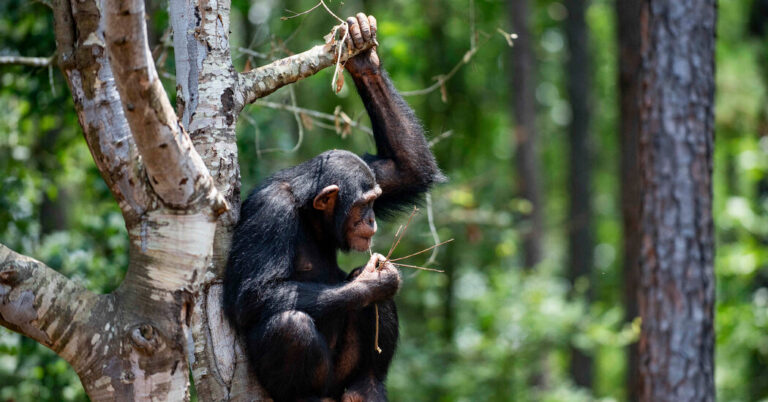Since she began working at The New York Times in 2021, Emily Anthes has written about African malaria mosquitoes, video-chatting parrots, California condor parents, the deer that contracted Covid-19 and even an exhibit of 500,000 leafcutter ants. Animals, he said, are one of his main beats as a science reporter. So when he visited a chimpanzee sanctuary in June, he couldn’t ignore the connections between human nature and animal instinct.
“Even though we don’t know exactly what’s going on in their minds, they have many similar experiences to humans,” Ms. Anthes.
Ms. Anthes and photographer Emil T. Lippe traveled to Chimp Haven in Keithville, La., home to chimpanzees retired from biomedical research, to report on how the sanctuary prepares its residents for severe and unexpected weather. Staff use noises from things like cowbells or sound machines to coax the chimps from the forest to the shelter. The goal is to condition the chimps so that they have a regular response to storms.
A few days after visiting Ms. Anthes in Chimp Haven, a strong storm knocked down trees and impassable roads around Keithville. The storm added new urgency to the staff’s mission to keep chimps safe in a more volatile climate, and it became the driving force behind Ms. Anthes.
In an interview, Ms. Anthes his journey in reporting and why it is useful to compare the weaknesses of animals with humanity. This interview has been edited and condensed.
How do you prepare to report a longer narrative article?
I always sketch out a bullet-point list of questions ahead of time. I don’t keep it in front of me, but always at the end of the day, or before I get ready to leave, I’ll say, Hey, can you give me a minute? I’ll just double check and make sure I didn’t miss something I wanted to ask.
When I’m out in the field reporting, I collect everything in the atmosphere — how things feel, look, smell, sound. When I call someone from my desk, I try to get those things from them, but in this case, it’s on me to pick up all those details and get them noticed the first time.
What is it like to experience the sanctuary? Is there anything you don’t have space or time to put into the article?
The story has this narrative component of bringing people into what happened after the great storm. But the funny thing is that the storm happened right after my visit. When I went, I didn’t know that there was going to be this intense storm, which would be in the story, which would give structure to the narrative. I was too focused on what was happening that day. And, interestingly, the weather was pretty wild even on the day I was there.
Did that make you think about extreme weather in relation to people, and the kind of precautions we need to take?
The sanctuary staff is there to take care of these chimps, and they take that very seriously. But they also have a large staff and they also live and work in the area. They are also affected by the events of this period. Sometimes you get very little warning. What would you do if a tornado was coming in five minutes and you had to take shelter? They said, Well, staff safety comes first.
In an article like this, are you trying to avoid showing too many human qualities in animals?
I write a lot about animals, and it’s always been a tricky line. From a scientific point of view, we certainly don’t want to anthropomorphize animals. They are not human. They are beings with their own way of being in the world, processing the world and moving through the world. But sometimes anthropomorphizing is considered a dirty word. Sometimes it is useful to draw parallels between animal experiences and human life.
This can cause the reader to relate more to the topics you are writing about, even if it is not a person.
There are certainly many reasons to believe that animals, especially chimpanzees, who are so closely related to us, have many similar experiences to humans. It’s not a big stretch to, in the case of this story, imagine that a chimp might be nervous or scared during a storm. They have complex social bonds and hierarchies, just as humans do. Some of that isn’t a huge stretch. In some ways, it would be surprising if they didn’t have experiences very similar to ours.
